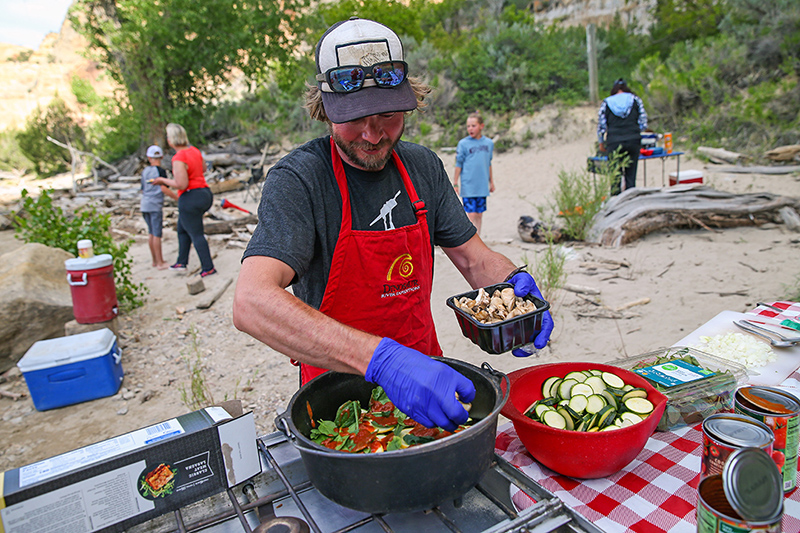If you have your first water rafting expedition coming up, you will have a great time! However, you can enhance your experience by paying attention to a few essential wardrobe must-haves to keep you safe and comfortable. Water rafting is usually an all-day activity, so you must take proper steps to protect yourself from the elements. Read on to learn what attire is best for water rafting.
Rash Guard Paired With Board Shorts
When it comes to water rafting, safety and comfort should be your top priorities. It’s important to wear clothes that are quick-drying, breathable, and offer protection from the sun and water.
An idea for a water rafting outfit is a rash guard paired with board shorts. Rash guards are typically made from stretchy, moisture-wicking fabric that will keep you cool and dry throughout the day. They also offer UPF protection from the sun, which is important when you’re spending extended periods of time outdoors. Board shorts are also a great choice, as they are lightweight, quick-drying, and won’t restrict your movement. Look for ones with a secure waistband and pockets with closures to keep your valuables safe.
It’s best to avoid cotton or any materials that will absorb water, as this can leave you feeling heavy and uncomfortable. Instead, opt for synthetic materials like polyester, nylon, or spandex. For added protection, you can also wear water shoes or sandals with good grip, which will help you maintain your balance on slippery surfaces.
Water rafting would also include a hat with a brim to protect your face and neck from the sun. You can also bring along a lightweight, waterproof jacket in case of unexpected rain or wind.
Overall, it is suggested to choose clothes that are functional, comfortable, and offer protection from the elements. With the right outfit, you can focus on enjoying the thrill of the rapids without any wardrobe distractions.
Swimsuit, Quick-dry Shirt & Pants, Water Shoes, Personal Floatation Device
Swimsuit
Wear a swimsuit underneath your clothing as a base layer. Choose a comfortable one that fits well and allows for easy movement.
Quick-dry shirt
Opt for a synthetic or moisture-wicking shirt that dries quickly, such as those made from polyester or polypropylene. Avoid cotton, as it retains water and takes a long time to dry.
Quick-dry shorts or pants
Wear quick-drying shorts or pants, preferably made from a lightweight, synthetic material like nylon. Again, avoid cotton for the same reasons mentioned above.
Water shoes or sandals
Choose footwear that provides a good grip on wet surfaces and drains water easily. Options include water shoes, sandals with straps, or even old sneakers that you don’t mind getting wet. Avoid flip-flops, as they can easily slip off in the water.
Personal flotation device (PFD)
Make sure to wear a well-fitting, Coast Guard-approved life jacket or PFD, which is an essential piece of safety equipment for water rafting.
Helmet
Some rafting trips, especially those on more challenging rivers, require wearing a helmet for added safety.
Wet suit or dry suit (optional)
Depending on the water temperature and weather conditions, you may want to wear a wet suit or dry suit to help you stay warm in cold water.
Sun protection
Apply waterproof sunscreen and wear sunglasses with a strap to protect your eyes from glare on the water. A wide-brimmed hat can also be helpful for sun protection, as long as it fits securely.
Layering for Temperature Control and Sun Protection
1. Quick-drying clothing
Opt for synthetic materials such as polyester or nylon, as these fabrics dry faster than cotton. Wearing moisture-wicking shorts and shirts will keep you comfortable and prevent chafing during your rafting adventure.
2. Layering for temperature control
Depending on water and weather conditions, you might need to add or remove layers throughout your rafting trip. For colder conditions, consider wearing a base layer like a rash guard, a thermal top, or a wetsuit. In warmer weather, a light, long-sleeved shirt can provide sun protection without causing overheating.
3. Footwear
Water shoes, sandals, or old sneakers with good grip are ideal for rafting, as they keep your feet protected from rocks and debris while providing traction on slippery surfaces. Avoid flip-flops or heavy hiking boots, as they’re less suitable for water-based activities and may hinder your movement.
4. Sun protection
In addition to sunscreen with a high SPF, consider wearing a wide-brimmed hat or a cap with a neck flap to ensure ample coverage for your head, neck, and ears. Sunglasses with a retention strap are also recommended to protect your eyes from harmful UV rays and glare.
5. Personal flotation device (PFD)
This is a non-negotiable item for water rafting, as it ensures your safety in the event of capsizing or navigating rough waters. While most rafting operators provide PFDs, it’s vital to make sure they fit properly and are adequately buckled up.
Wet or Dry Suit and Proper Accessories
Water rafting is an adventurous activity that requires proper gear and clothing to ensure safety and comfort throughout the experience. When it comes to dressing for water rafting, it’s important to consider factors such as weather conditions, water temperature, and the intensity of the rapids. In this article, we’ll explore some ideas on what kind of outfit to wear for water rafting.
● Wet Suit or Dry Suit
If you’re planning to go water rafting in cold water, a wet suit or dry suit is a must-have. These suits are designed to keep your body warm and dry, even in the coldest of waters. Wet suits are made from neoprene, which is a type of rubber material that insulates the body and provides buoyancy. Dry suits are made from waterproof material and are designed to keep you completely dry.
● Quick-drying Clothing
If you’re rafting in warm weather, quick-drying clothing is the way to go. Cotton clothing should be avoided as it retains moisture, which can make you feel cold and uncomfortable. Instead, opt for synthetic materials like polyester or nylon. These materials wick away moisture and dry quickly, ensuring you stay comfortable throughout the day.
● Swimwear
If you’re going water rafting on a warm day, swimwear is a good option. However, it’s important to choose swimwear that is comfortable and secure. Avoid wearing bikinis or loose-fitting swim trunks as they can easily come off when you hit the rapids. Instead, choose a one-piece swimsuit or snug-fitting swim trunks that won’t get in the way during the activity.
● Footwear
When it comes to footwear, it’s important to choose shoes that will protect your feet and provide good grip on wet surfaces. Water shoes are a great option as they are designed to be worn in and around water. These shoes are made from materials that dry quickly and have good traction on wet surfaces. Sneakers or sandals should be avoided as they can easily slip off your feet or get caught in the rapids.
● Accessories
Accessories like sunglasses, a hat, and sunscreen are also important for water rafting. Sunglasses will protect your eyes from the sun’s glare, while a hat will keep your face and neck shaded from the sun. Sunscreen is also essential as you’ll be spending hours in the sun. Make sure to choose a waterproof sunscreen that won’t wash off in the water.
This is a crowdsourced article. Contributors’ statements do not necessarily reflect the opinion of this website, other people, businesses, or other contributors.






